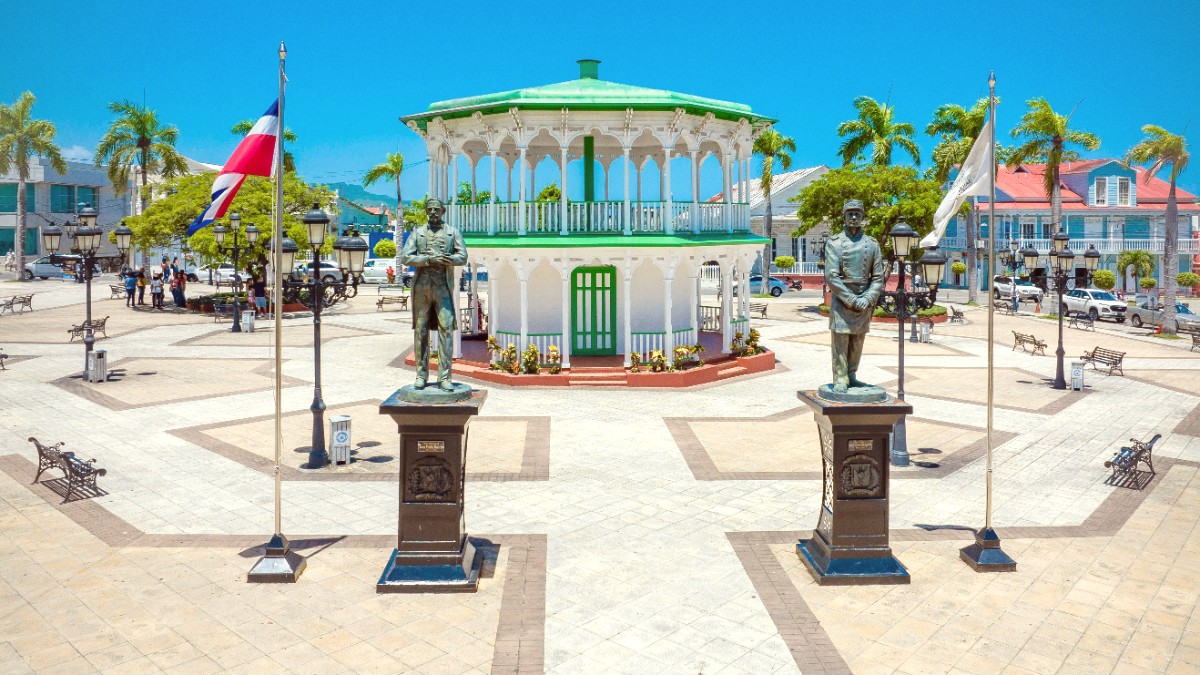
Dominican Republic
Dominican food tells a story of cultural fusion. Spanish influences brought ingredients like rice, wheat, and meats. African influences contributed plantains, root vegetables, and slow-cooking methods. Many traditional recipes still use these staples.
The cuisine centers on staples like rice, beans, and plantains, combined with various meats and fresh seafood, all infused with aromatic herbs and spices. It is mainly savory, with subtle sweet notes from ripe plantains or coconut.
The cornerstone of Dominican cooking includes white rice, red beans, and various forms of plantains. Other common ingredients are yuca, ñame, yautía, various meats, and fresh seafood, especially in coastal areas.
The "sofrito" or "sazón" forms the flavor base for many dishes, made from finely chopped or blended garlic, onions, bell peppers, cilantro, and oregano. Sour orange ("naranja agria") gives a tangy note in marinades. Annatto ("achiote") adds natural color.
While core dishes remain consistent, coastal areas like Puerto Plata place a strong emphasis on fresh seafood. You find excellent fish dishes, often fried whole ("pescado frito") or stewed in coconut milk ("pescado con coco"), leveraging the daily catch. Access to fresh tropical fruits also means a wider variety of fresh juices and fruit-based desserts.
This is the national dish and a cornerstone of Dominican daily meals. It consists of white rice, stewed red beans, and meat (most commonly stewed chicken or beef, cooked with vegetables and a savory sauce).
It is often served with a side of "tostones" (fried plantain slices) or a simple salad. Find this dish everywhere, from humble local "comedores" to larger restaurants.
A hearty, rich stew considered a national treasure, especially popular for celebrations or on cooler days. It is made with seven different types of meat and a variety of root vegetables.
It cooks slowly, creating a thick, flavorful broth. Often served with white rice and avocado.
Mashed green plantains mixed with garlic and crispy pork cracklings ("chicharrón"). This mixture is shaped into a ball. It is often served with a savory broth on the side or stuffed with chicken, beef, or seafood.
While originating from Puerto Rico, it is a very popular dish in the Dominican Republic.
The national spirit. The Dominican Republic is renowned for its high-quality rum. Brugal and Barceló are the most prominent local brands, presenting a range of aged and unaged rums.
An alcoholic drink made by steeping rum, red wine, honey, various herbs, and tree bark in a bottle for several weeks. It is believed to have medicinal and aphrodisiac properties and holds an unique, complex flavor.
Fine dining establishments are mainly found within upscale all-inclusive resorts. A few independent high-end restaurants exist in Puerto Plata that cater to tourists and affluent locals.
Numerous mid-range options exist in the city center, along the Malecon, and near tourist areas. These restaurants offer a mix of traditional Dominican cuisine and popular international dishes.
"Comedores" are small, local, informal eateries that serve traditional Dominican lunch platters ("La Bandera Dominicana") at very affordable prices.
Located in the city center, this bustling market presents a sensory experience. While mainly for fresh produce, meats, and seafood, you find small, informal food stalls within or around it. It is a great place to observe local life and find fresh ingredients.
Large supermarkets (e.g., Jumbo, La Sirena) offer a wide selection of groceries, including local and imported products, fresh produce, and baked goods.
Puerto Plata, especially within the resort areas and in nearby towns like Sosúan and Cabarete, features a range of international cuisine options.
You find Italian, Chinese, American fast food chains, and some fusion restaurants. This diversity is for travelers who prefer familiar tastes or want a break from local dishes.
Finding vegetarian options in traditional Dominican cuisine can be challenging but is becoming more common. Vegan options are more difficult. Resort buffets often have more varied options and separate stations for salads and vegetables.
Very limited availability. Some specialized international hotels or resorts might cater to specific dietary needs if requested in advance, but it is not a standard offering. Travelers with strict requirements may need to self-cater.
Dominican cuisine naturally uses a lot of rice and gluten-free root vegetables. Cross-contamination can be an issue. Clearly communicate your dietary needs. A translation card helps.
Online forums, dedicated dietary travel blogs, or apps might list specific restaurants that cater to certain needs, but direct communication with restaurant staff is the best approach.
Many restaurants along the Malecon in Puerto Plata or directly on the sand in Sosúan and Cabarete feature dining experiences right on the beach, with stunning ocean views and the sound of waves.
This creates a relaxed and memorable atmosphere.
All-inclusive resorts feature a variety of themed restaurants (e.g., Italian, Japanese, Mexican, steakhouse).
These offer diverse culinary experiences within one property, often with different ambiances and specialized menus.
Dulce de Coco: sweet coconut candy. Arroz con Leche: creamy rice pudding, seasoned with cinnamon.
Pastelitos: similar to empanadas but often smaller and with lighter, flakier crusts. Yaniqueque: a large, thin, crispy fried dough disc.
Opportunities exist to visit coffee or cacao plantations in the hills surrounding Puerto Plata (e.g., near Altamira).
Located in Puerto Plata, the Brugal Rum Distillery offers tours that explain the rum-making process from sugarcane to bottle.
Local festivals, like Patron Saint festivities or town fairs, feature traditional foods and street vendors, a chance to sample a wide array of local delicacies.
Sweet coconut candy, often in a small, chewy square. Creamy rice pudding, seasoned with cinnamon and sometimes raisins.
A moist sponge cake soaked in three kinds of milk. Creamy caramel custard dessert.
A refreshing array of freshly squeezed tropical fruit juices. Popular choices include passion fruit, mango, soursop, pineapple, and tamarind.
The Dominican Republic produces excellent coffee. Enjoy it strong and sweet, often served as "cafecito."
Crispy fried pork belly or skin, a popular savory snack.
Observe local customs and tipping norms for a harmonious dining experience.